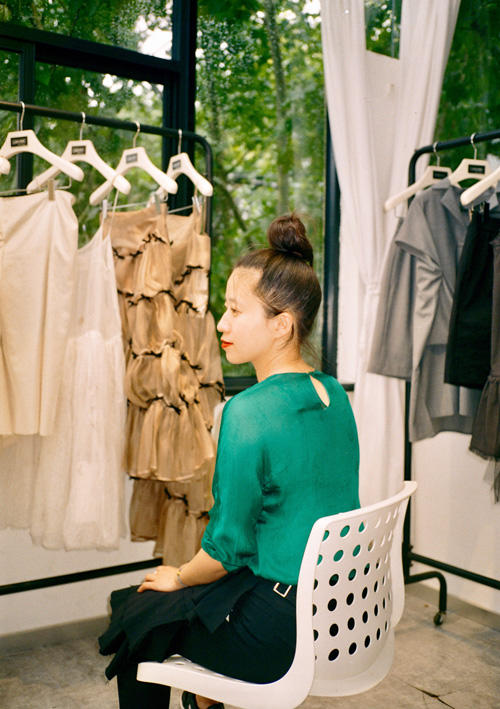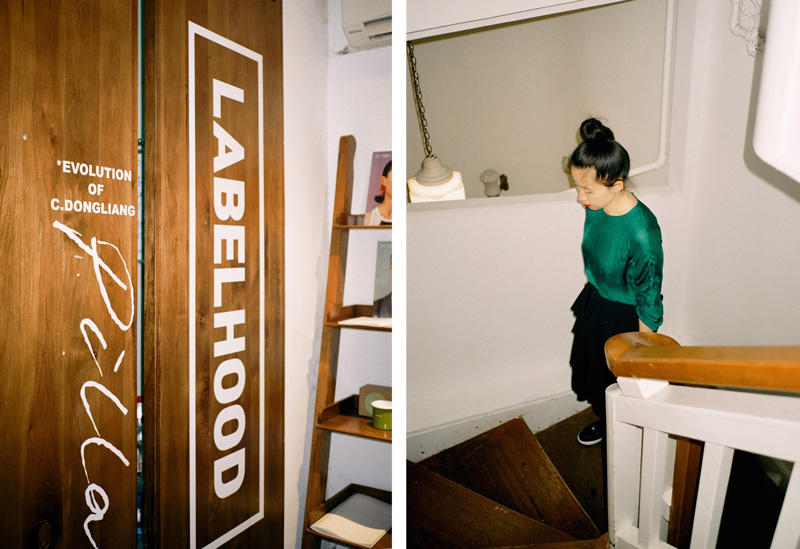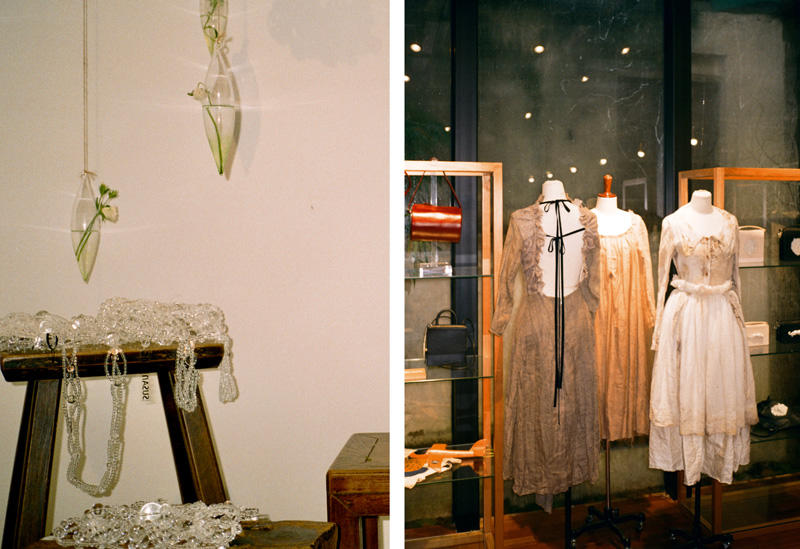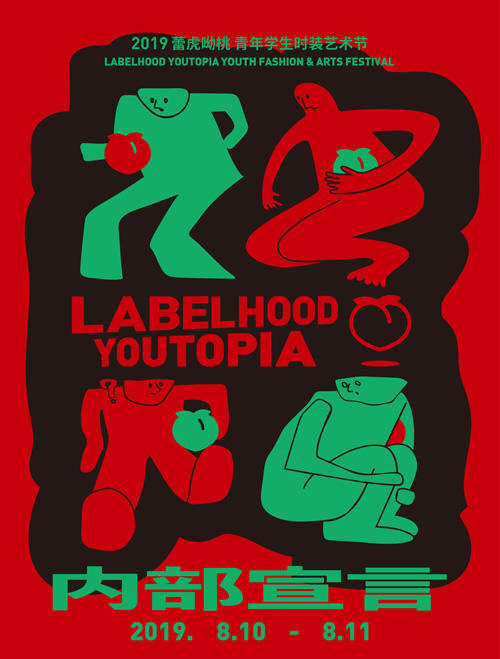
THE NEXT GENERATION OF CHINESE DESIGN
Labelhood’s Tasha Liu Takes the Lead
Words and photography by Bohan Qiu / Editorial assistant Raja Chin
If you’re familiar with Chinese fashion or have been to Shanghai Fashion Week, Labelhood would definitely be a word you’d remember. The Shanghai-based emerging designer boot camp isn’t just a fashion show organiser — it’s a community and fashion retailer. Led by founder Tasha Liu, Labelhood has not only revolutionised the way we think of fashion weeks but has also played a crucial role in building up the ecosystem within China and acted as the engine behind Chinese design going global.
Since founding Labelhood in 2016, Tasha has built it into a globally renowned platform for launching new talent in China. Labelhood hosts SHUSHU/TONG, Angel Chen, FFIXXED STUDIOS, PRONOUNCE and other Chinese designers setting the agenda today, as well as tirelessly continuing to search and support newcomers every season, providing them with runway opportunities, strategic support and, more importantly, the ecosystem behind. This year, Lane Crawford has also announced a strategic partnership with Labelhood to have the platform open pop-up stores across Lane Crawford’s flagships in Hong Kong SAR, Beijing, Shanghai and Chengdu, focusing on emerging Chinese talents and providing scholarships to support the most promising of them.
In only her early 30s, Tasha has established herself as the “godmother” of Chinese independent fashion. But she’s not retiring anytime soon. We spoke with her at Labelhood’s Fumin Road flagship store about her views on the current state of Chinese fashion, and what the future holds.

With the Chinese fashion scene being particularly empowered by digital and social media, the relationships between creators and consumers are changing drastically. What’s your view of the current state?
I don’t think it’s just driven by money anymore. Everybody has the ability to be a content creator. It’s not limited to designers — consumers are increasingly essential content creators themselves. In a market like this, interesting local and original content from the consumers or the designers would be much more beneficial in stimulating consumption within the domestic market. Labelhood has flourished under this kind of wider market. We bring together the new fashion creators from everywhere to combine their energies. I foresee more chemistry happening within this community in the future, giving birth to more original, innovative content that's increasingly unique to China.
Labelhood has always been at the forefront of discovering and nurturing new creative talent, and played an essential role in pushing for a greater ecosystem within the industry. What’s happening with Labelhood now, and what are the next steps?
Labelhood is a brand-new creation, which was initially designed to connect consumers’ purchasing demand with design by providing visibility and availability for designers. We didn’t want to speak for the designers, but instead to gather voices from across the industry to express a more powerful statement. Labelhood is essentially a curator. We spread this content and these ideas to key partners organically and effectively. As a leader in the retail industry, Lane Crawford is a very suitable partner. In the future, we may work with even more partners ranging from music to education and other industries to connect with the customer base. But at the basic level, we identify ourselves as an organiser of fashion events, aiming to curate this context on a broader scale.
What’s the difference between the current generations like Angel Chen, SHUSHU/TONG, YIRANTIAN and the newcomers like MING MA and MÄRCHEN?
Nowadays, emerging designers have already considered the merchandising of their brands as a very high priority. That’s compared with the first generations like Ms MIN and Chictopia, which would use one or two key looks from each season to convey their own images and tell their personal stories. Designers today pay more attention to their marketability and product categories. Designers like SHUSHU/TONG and Angel Chen are continuing their evolution. They started out with identities that resonated well with their audiences, and now they’ve become reputable houses of their own that feel like complete brands.

The first generations of Chinese designers were eager to showcase their identities being Chinese, while the new generations are focusing on their personal level of beauty standards. Does this have to do with a market shift in mentality?
This is largely due to the overall market shift. Even just seven or eight years ago, many designers coming home from studying abroad had a hard time calling themselves a “Chinese designer”. Nowadays, there’s an acceptance of that due to the results of efforts by retailers and fashion media alike, and more importantly, growing pride from consumers. Across the entire market, Chinese designers have grown a much stronger sense of identity, and the designers have gone from avoiding it to admitting it to, later on, embracing it. Now it’s just something that comes out naturally without emphasising it on purpose.
Shanghai Fashion Week has risen to become a key global fashion destination quickly. Why do you think Shanghai is different from London/New York/ Paris?
Shanghai is a vibrant city with a very high acceptance of anything new. With the support of modern technology, new things and different cultures can enter our vision faster than other cities. Labelhood already occupies one-third of Shanghai Fashion Week’s schedule. The designers we support each time are almost entirely new, which is unlikely to happen in other cities. Everyone here waits and is hungry for newness, and they’re very receptive to it.
Do you see a “Chinese style” in fashion developing over the years, as compared to, say, a Korean/Japanese style?
This style is taking shape, but is not yet shaped. China is a massive country with all types of culture influencing one another, so we have more cultural diversity than some other countries. There’s a certain sense of craftsmanship, which we have in common with Japanese and Korean culture. On the other hand, the diversity of Chinese culture, even within the country, plays a huge role in shaping our own perspectives. Also, in China, the existence and popularity of e-commerce are beyond those of other countries. So we must be open-minded, and let Chinese fashion blossom in every way possible.
In the past 30 years, Chinese millennials grew up in an era where the country opened up to the west, and foreign products poured into this monstrous market. Local and domestic brands quickly became obsolete when facing the competition of incoming Western products. But Generation Z in China has grown up in a time when China is designing and producing products and brands that are of just as high a quality. For them, the concept of “foreign” and “local” is becoming increasingly irrelevant. They’re receiving information completely in sync with the rest of the world, and have learned to extract what they most identify with.

“Future”, “youth”, “new-gen”, “eco-system”. These are the key words across the fashion industry in Shanghai. Everybody is incredibly optimistic about the community and how it will nurture greater creativity. Recently, Labelhood also hosted the very first “Youtopia” festival, aiming to encourage and inspire the next generation of youth to start creating, expressing and consuming.
Youtopia is a new creative festival focusing on university students. It includes talks hosted by industry leaders from the likes of BOF China Editorial Director Queennie Yang and Modern Weekly’s Karchun Leung; a career fair with fashion brands and magazines in China looking for young talent; an education fair partnering with Istituto Marangoni Shanghai, Istituto Europeo di Design and more; as well as a runway show where 45 fashion students showcased one look each, while established designers Angel Chen, Pronounce’s Yushan Li, Xu Zhi and THE FLOCKS provided mentorship programmes. All of it is a clear sign that Labelhood is holding firm in continuing its effort to nurture future industry talent by giving young designers a foot in the door.
You’re working on a younger Labelhood programme, Youtopia, at the moment. What’s the purpose and thinking behind that?
Whoever captures the minds of young people will capture the future. Students today have a higher degree of self-awareness and understanding of their identity. Spreading Chinese design in this community can receive more mutual recognition. Children in China are highly independent, and the younger generations will gradually affect the older ones. So we should communicate with the next generation earlier at this point, which is something every brand needs to learn.
In what areas do you think Chinese independent designers still have room for improvement?
Our strong support for them can be a double-edged sword. Nowadays, Chinese designers can receive more support from this environment and market than many other countries. So the most important thing is how the designers can adjust their mindsets to succeed in the long run. Are you trying to build yourself, or are you trying to build a brand? Can you comprehend the whole market when you put yourself in a more competitive environment? Many designers graduated abroad then landed in Shanghai. They only engage with the most mature consumer groups at first. But when we talk about the Chinese market, we need to be more in line with the local market strategy, while learning more about the needs of people from other cities outside of Beijing and Shanghai. What are they watching? What are they interested in? These are things that professors in the West can’t teach you, so you must keep an open heart and a flexible way of thinking to learn and understand. Designers shouldn’t live in an illusion they create for themselves.
You’re bringing designers to show in Milan and New York. What’s the significance and the implication of exporting these local designers to show overseas today?
Chinese designers are gradually becoming less dependent and reliant on international fashion weeks to be recognised. They’ve also built a recognition system that’s unique to China to receive a stamp of approval from the market. Staging a show nowadays in the West has more to do with how we can convert the buzz into sales through the brands’ own e-commerce channels. But there are also many designers, like Uma Wang, who still need to continuously engage with their international audiences. If designers want to have stable support and growth in the Chinese market in the short term, it’s core for them to learn how to play with the new rules in the local markets.
As a long-term partner of Lane Crawford and a judge of the Creative Call Out, what role has this project played in driving the development of designers?
Creative Call Out is a good endorsement for new designers and creatives. Back then, it wasn't an easy task for us to talk about Chinese fashion design. But having the stamp of approval from Lane Crawford definitely helped many designers to be seen and recognised internationally. Lane Crawford is very forward-looking in this area — today people are willing to go there and check out which Chinese designers can balance creativity with commercial success. Lane Crawford has laid a solid foundation through the Creative Call Out programme, and positioned itself at the centre of this innovation. Now it’s also planning to expand this category and involve more participants. This will better enable each one of them to play a better role in this fashion ecosystem.
With a diversified digital ecosystem that has proliferated over the years, China now has a completely different set of playing rules that are separate from the Instagram/Snapchat strategies in the West. Apps like Xiaohongshu and TikTok are on the rise among millennial and Gen-Z customers, and this has influenced brands in rethinking and repositioning their strategies on how to engage with consumers.
Tasha is intrigued and passionate about technology and digital platforms, particularly in how fashion is able take advantage of them. She’s often referred to as the “future leader” among Chinese designers, taking the “fashion army” not only across the local markets but into the international arena.
Have you discovered anything interesting or any cool new concepts recently that you think are crafting a new path?
The app “Tezign”. It’s a platform that gathers many great graphic designers in China. Nowadays, the supply of talent in the market is increasing. Big companies publish tasks in this app and agencies and individuals upload their portfolios to pitch for projects. I find it interesting to simplify complex communication costs through the help of technology.
In a market where social media, e-commerce and new retail are changing every day, what are some approaches you’re experimenting with or want to experiment with?
Compared with Tmall or Taobao, the emergence of Xiaohongshu is absolutely a new trend, and it’s a platform with distinct Chinese characteristics. Xiaohongshu is not just a simplified version of Instagram, it contains many product descriptions and product placements that are quintessentially Chinese. Nowadays, Chinese designers should study what young people focus on from the perspective of social media. Especially in the second-tier and third-tier cities, people are yearning for the fashion and lifestyle of world-class cities like Shanghai and Beijing today. So it’s important to know how to communicate with them.
What are your personal favourite spots in Shanghai when you’re off-duty?
I often go to a second-hand furniture shop on Wuyuan Road named Sigma. Otherwise, Lolo Love Vintage — owned by a friend — on Yongfu Road is also always good to hunt through. Then there are the art museums like Power Station of Art or Tank Shanghai that are worth checking out — in fact, Labelhood has done shows at both of them!